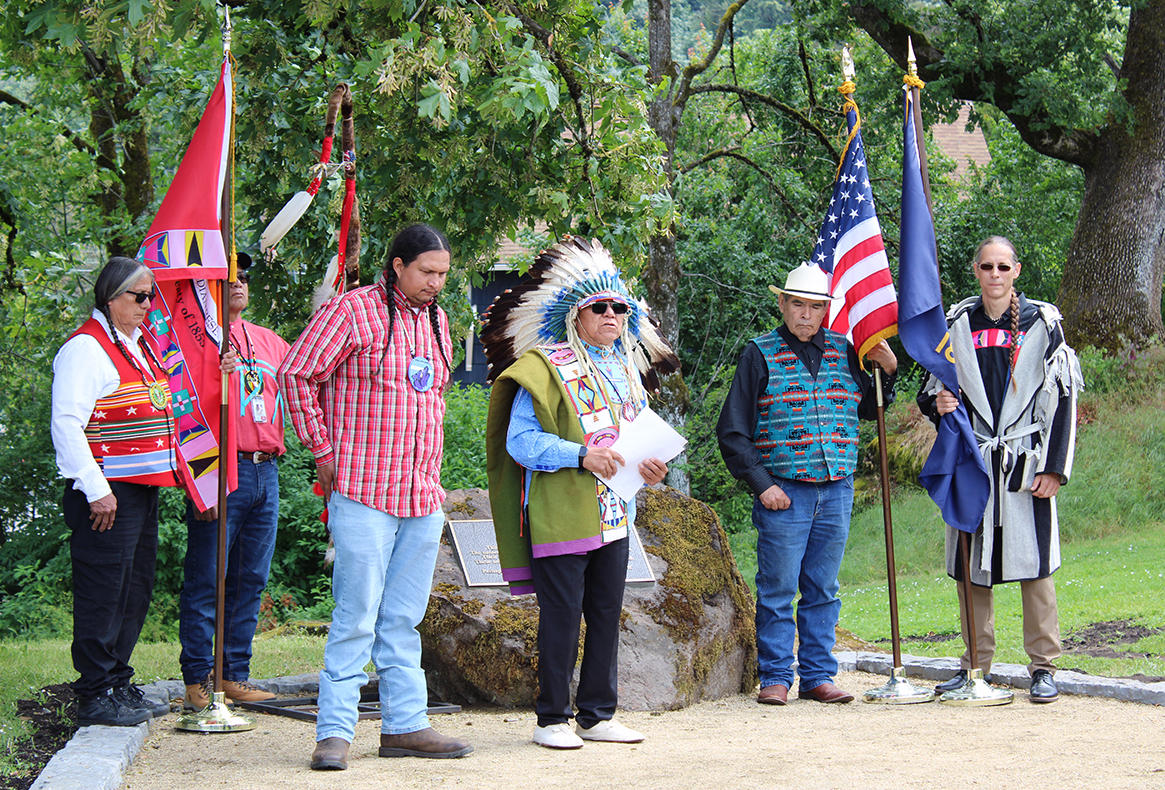
- Details
- By Native News Online Staff
On June 3, the Confederated Tribes of the Umatilla Reservation (CTUIR) and Oregon City officials commemorated five Cayuse men who were wrongfully arrested and executed in the 19th century.
The event marked the dedication of a historical interpretive panel and a boulder at McLoughlin Promenade, overlooking the site where the men were put to death by hanging in 1850 near Willamette Falls.
According to CTUIR historians, Marcus Whitman, who established the Whitman Mission in the Walla Walla Valley, was suspected of coveting Cayuse lands and spreading diseases among the Cayuse people in 1847.
On November 29, 1847, Cayuse tribesmen attacked the mission, resulting in the deaths of thirteen people, including Whitman. The attack prompted a militia to form, leading to the Cayuse War.
In 1850, five Cayuse men volunteered to discuss the killings at Whitman Mission but were arrested, tried, and hanged. The five men were Tiˀílakaˀaykt, ˀIceyéeye Siléis, ooá Šaqíin, Tamáhas and ƛókomooc.
The journey to honor these men began in 1991 when then-CTUIR Board Trustee Armand Minthorn collaborated with former Oregon City Mayors Dan Fowler and Alice Norris. The effort aimed to find ways to honor the men.
Last Monday, more than 100 people, including members of the CTUIR and local leaders, gathered despite cool temperatures and strong winds to honor the men. The site, chosen for its proximity to where the men were detained, tried, and hanged, holds significant importance to the CTUIR.
“The five Cayuse men that we are remembering today have a very important role in the history of the Cayuse people. We are here because of these five men who gave their lives for the future of their people. They made the ultimate sacrifice,” said CTUIR Chairman Gary I Burke in a press release. “Their last breaths were here in Oregon City, on this day, June 3, 174 years ago. For more than three decades, individuals from our Confederated Tribes of the Umatilla who descend from the families of these men, leaders and headmen, and elected officials have worked to remember these five men, their lives, and their deaths.”
Efforts to identify the graves are ongoing, complicated by conflicting historical accounts and changes in infrastructure and landscape over time. The interpretive panel at the site lists the names of the five men and narrates their story.
Later, the late CTUIR Trustee Les Minthorn, who descended from the families of the hanged men, expressed the CTUIR’s desire to find the ancestors’ remains and bring them home for proper burial.
In 2021, the Oregon City Commission approved funding for the tribute project, which commenced on May 6, 2024, and was completed just before the June 3 dedication ceremony.
“We are here today to acknowledge a wrong that occurred in our community in 1850 and its part of our collective history. We are here to reflect and to never forget,” Oregon City Mayor Denyse McGriff said during a reception at the Museum of Oregon Territory after the ceremony.
The event concluded with a proclamation by Mayor McGriff and city commissioners, declaring June 3, 2024, as the Cayuse Five Day of Remembrance in Oregon City.
More Stories Like This
Native News Weekly (August 25, 2024): D.C. BriefsUS Presidents in Their Own Words Concerning American Indians
Indigenous Actor Elaine Miles Reports Detention by Alleged ICE Agents
Happy Thanksgiving from Native News Online
Coming Up on Native Bidaské: Behind the Animation: Joey Clift Talks “Pow” and Native Storytelling
Help us tell the stories that could save Native languages and food traditions
At a critical moment for Indian Country, Native News Online is embarking on our most ambitious reporting project yet: "Cultivating Culture," a three-year investigation into two forces shaping Native community survival—food sovereignty and language revitalization.
The devastating impact of COVID-19 accelerated the loss of Native elders and with them, irreplaceable cultural knowledge. Yet across tribal communities, innovative leaders are fighting back, reclaiming traditional food systems and breathing new life into Native languages. These aren't just cultural preservation efforts—they're powerful pathways to community health, healing, and resilience.
Our dedicated reporting team will spend three years documenting these stories through on-the-ground reporting in 18 tribal communities, producing over 200 in-depth stories, 18 podcast episodes, and multimedia content that amplifies Indigenous voices. We'll show policymakers, funders, and allies how cultural restoration directly impacts physical and mental wellness while celebrating successful models of sovereignty and self-determination.
This isn't corporate media parachuting into Indian Country for a quick story. This is sustained, relationship-based journalism by Native reporters who understand these communities. It's "Warrior Journalism"—fearless reporting that serves the 5.5 million readers who depend on us for news that mainstream media often ignores.
We need your help right now. While we've secured partial funding, we're still $450,000 short of our three-year budget. Our immediate goal is $25,000 this month to keep this critical work moving forward—funding reporter salaries, travel to remote communities, photography, and the deep reporting these stories deserve.
Every dollar directly supports Indigenous journalists telling Indigenous stories. Whether it's $5 or $50, your contribution ensures these vital narratives of resilience, innovation, and hope don't disappear into silence.
 The stakes couldn't be higher. Native languages are being lost at an alarming rate. Food insecurity plagues many tribal communities. But solutions are emerging, and these stories need to be told.
The stakes couldn't be higher. Native languages are being lost at an alarming rate. Food insecurity plagues many tribal communities. But solutions are emerging, and these stories need to be told.
Support independent Native journalism. Fund the stories that matter.
Levi Rickert (Potawatomi), Editor & Publisher

